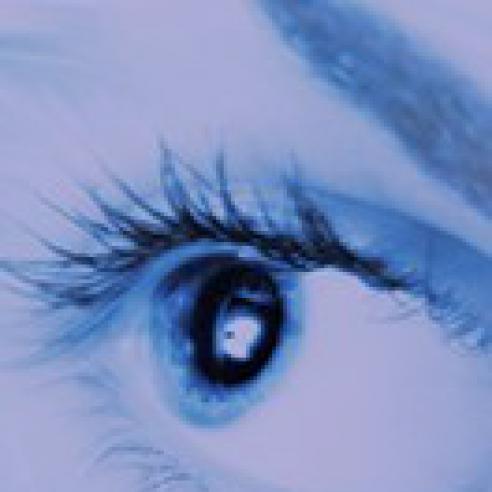Getting Around With Visual Impairment
People who could benefit from rehabilitation
[Note: this is an older, but still potentially useful, article from the RPB archives.]
Kathleen A. Turano, Ph.D.
Associate Professor
Wilmer Eye Institute, Lions Vision Center
The Johns Hopkins School of Medicine
Associates: Duane R. Geruschat, Ph.D., Harry A. Quigley, M.D.
SUMMARY AND SIGNIFICANCE
Glaucoma, a slowly progressive optic atrophy that affects 2.5 million Americans1, causes progressive loss of peripheral vision and loss of contrast sensitivity (the ability to detect small differences in light intensities). Restricted visual fields and loss of contrast sensitivity make it difficult for people to walk safely and efficiently (“mobility”)2–6. Rarely do vision-impaired people take a casual stroll by themselves. The seemingly simple act of walking can be hard work, especially in unfamiliar places.
We have shown that a high percentage of patients with glaucoma, even early-stage disease, have difficulty with mobility:
- They walk more slowly than normally sighted people.
- They suffer more bumps, stumbles, and falls as the disease progresses.
- They believe they are less able to travel alone.
- They limit travel by themselves.
- They have to expend more mental effort when walking in unfamiliar or visually demanding places (e.g., places with stairs or variable lighting) than normally sighted people.
Problems with mobility lead visionimpaired people to limit their independent travel. Their reduced activity and exercise make them more homebound and isolated, and increase their risk for loss of independence, depression, and an overall decline in health7.
Our results indicate that simple environmental modifications such as proper lighting, handrails on stairways, and, whenever possible, the elimination of uneven surfaces, could make travel easier for vision-impaired people. We have also found that very few glaucoma patients have received rehabilitation training that helps them travel more safely. Clinicians should ask all glaucoma patients whether they are having mobility problems; this simple screen may identify
Finally, our results point up the need to develop rehabilitation strategies and aids that will reduce people’s cognitive (mental processing) load during mobility. Many of the electronic travel aids, through the use of sensors (laser light, sonar), give the user large amounts of information to help make safety decisions. However, many of these devices have been found actually to detract from safe travel because they require the user to process the artificial input, thereby increasing cognitive load.
BACKGROUND
Research on vision impairment and mobility is relatively new and has focused primarily on identifying the visual function predictors for the traditional measures of mobility: time required to complete an established travel path and the number of mobility incidents (e.g., bumps, loss of orientation). One of the early studies, by James Marron and Ian Bailey from the University of California School of Optometry (1982)3, showed that the best visual function predictors of mobility are the extent of the visual field and contrast sensitivity. This is understandable when one considers what is involved in visually guided mobility. To walk safely, one must detect potential obstacles in one’s path, determine their relative location, and plan a path to navigate around them. The visual information needed for this task is typically acquired through successive visual fixations (glances) over the scene. Within a single fixation, a normally sighted person can look straight ahead and potentially detect obstacles located at his or her side.
It is not this easy for a person with restricted visual fields or reduced contrast sensitivity. Persons with restricted visual fields can obtain less visual information in a single fixation, so they must redirect their fixation more often to acquire mobilityrelevant information. Redirecting fixation is costly, especially for persons with small visual fields. Thomas Kuyk and colleagues (1996) at the Department of Veterans Affairs Medical Center in Birmingham, Alabama have shown that persons with restricted visual fields have greater difficulty with mobility than individuals with just a loss of visual acuity2. Persons with reduced contrast sensitivity obtain poorer-quality visual information in a single fixation. Consequently, each fixation may require more information processing and/or decision making to identify targets and obstacles.
Studies of the effects of vision impairment on mobility have typically limited the performance measures to travel time (or walking speed) and the number of mobility incidents. However, measuring only observable mobility behaviors does not fully characterize the mobility experience. Decisionmaking abilities, environmental awareness, self-perception of ability, and overall mental effort may be equally important factors.
We have combined patient-based assessments of perceived ability and estimates of the mental effort required for mobility with the traditional mobility measures to produce a more comprehensive evaluation of people’s ability for independent mobility. Patient-based assessment is an estimate of what people believe they are capable of doing. Perceived ability may relate more closely to actual performance than does physical ability. We have also begun assessing the mental effort required for mobility. Persons who report mobility difficulties do not always bump or fall. Yet the seemingly simple act of walking requires more concentration for the person with vision impairment than for the person with normal vision.
TECHNIQUES
We evaluated independent mobility in 83 persons with various stages of glaucoma and 47 age-similar, normally sighted persons who served as controls. We tested the subjects’ vision impairment by measuring visual acuity, contrast sensitivity, and visual fields. Subjects were asked several questions about mobility-related behaviors, such as, “Do you limit travel by yourself due to your vision loss?” and “Have you fallen in the last year?” We also gave subjects a questionnaire that asked for ratings of difficulty in 35 mobility situations, and analyzed the data with Rasch analysis8, a type of latent trait analysis. From this analysis we were able to estimate the “perceived visual ability for independent mobility” for each person and the “required visual ability” for each of the 35 mobility situations. Mobility performance was assessed by time required to complete an established travel path and the number of mobility incidents.
In a second study, we added a component to the mobility evaluation: an estimate of the mental effort required for mobility. We tested mobility in situations that Rasch analysis had identified as requiring the most visual ability among the glaucoma subjects, as well as in situations requiring less visual ability. We tested 10 persons with glaucoma and 10 age-similar normally sighted persons. We estimated mental effort by having the subjects walk a predefined route at their normal pace (the primary task) while at the same time pushing a button on a hand-held apparatus as quickly as possible whenever they felt the apparatus vibrating (the secondary task). To estimate the amount of mental effort required for walking, we compared the reaction time to the randomly emitted vibrations obtained while walking, with the reaction time obtained while standing. This paradigm is based on the assumption that mental operations draw from a limited-capacity central mechanism and that interference between a primary and a secondary task can assess the extent to which the primary task makes processing demands on the limited central system9.
RESULTS
The prevalence of falling and fear of falling was significantly higher in persons with advanced glaucoma than in persons with normal vision. There was no difference in the prevalence of falling or fear of falling between persons with mild or moderate glaucoma and persons with normal vision. The study showed, however, that about onefourth of subjects with mild glaucoma reported that: they limited solo travel because of their vision loss; they believed that they were less able to travel alone on foot than people with normal vision; and, at least sometimes, they asked someone to accompany them when they left their home. This number increased to two-thirds for persons with advanced disease. Only 2% of the persons with glaucoma reported having had orientation and mobility training (training to help them move around better) and only 6% used a mobility aid (e.g., a white cane). These findings reveal a large gap between the number of persons who have difficulty with independent mobility to the point that they limit their travel and the number of persons who have had rehabilitation.
The analysis of the questionnaire data showed that perceived visual ability for independent mobility decreased with increases in vision impairment, and subjects’ walking speed was directly related to their perceived visual ability. The mobility situations shown to require the least visual ability were moving about in familiar areas, in the home, and at work. The situations requiring the most visual ability were moving about in areas with high glare, poor lighting, changes in lighting, or changes in depth (e.g., curbs and stairs). Walking speed was significantly slower in situations that subjects identified as requiring the most visual ability than in situations requiring less visual ability. Subjects expended significantly more mental effort to walk in the situations that required the most visual ability than in situations that required less visual ability. The amount of mental effort expended while walking in the situations requiring the most visual ability increased with increases in severity of vision impairment.
HUMAN INTEREST AND FUTURE DIRECTIONS
A 51 year old woman from Maryland with mild glaucoma has fallen three times in the last year and, not surprisingly, has a fear of falling. She reports no difficulty walking in familiar areas or moving about in the home. However, she has limited solo travel because of her vision loss and usually asks someone to accompany her when she leaves home. Despite her mobility problems, this woman does not use a mobility aid nor has she had any mobility training. She was unaware that such training was available.
Another woman, a 67-year-old from Maryland with advanced glaucoma, has fallen once in the last year and has no fear of falling. This woman reports no difficulty walking in familiar areas or moving about in the home, but she will not leave her home without someone accompanying her. She also was unaware that mobility training was available. She uses her husband as a sighted companion when she travels outdoors or indoors in unfamiliar areas.
Familiarity with a place makes a difference for the vision-impaired traveler. As illustrated in the two cases above, and reported previously10, people with vision impairment have no difficulty walking in familiar places. They also walk faster and expend less mental effort when walking the same route the second time around11. This familiarity effect indicates that the vision impaired traveler uses stored information about the layout of the place (a mental map) to help them get around. Persons with normal vision can easily make repeated “looks” at the scene to identify the relative location of targets and obstacles. The world before them can serve as an external memory; they need not commit to memory a precise mental map in order to navigate. However, this does not hold true for persons with visual field loss. It may be easier for persons with small visual fields to store and retrieve a mental map than to make repeated fixations of the scene. For a person with vision impairment, putting together the pieces of the scene sampled through many fixations may be more difficult than working from memory. We have just begun to look at how vision impairments affect a person’s eye and head movements made in scanning the scene during mobility. An understanding of the scanning strategies used by visionimpaired persons may provide insight into what visual information is needed to get around and how that information is obtained and processed. This understanding could then be used to guide the formulation of effective visual scanning training strategies for safe and efficient travel.
This research has been supported by the National Institutes of Health/ National Eye Institute, grant #EY07839.
REFERENCES
(1) Quigley HA, Vitale S. Models of open-angle glaucoma prevalence and incidence in the United States. Invest Ophthalmol Vis Sci 1997;38:83-91. (2) Kuyk T, Elliott JL, Biehl J, Fuhr PS. Environmental variables and mobility performance in adults with low vision. Journal of the American Optometric Association 1996;67:403-409. (3) Marron JA, Bailey IL. Visual factors and orientation-mobility performance. Am J Optom Physiol Opt 1982;59:413-426. (4) Lovie-Kitchin J, Mainstone J, Robinson J, Brown B. What areas of the visual field are important for mobility in low vision patients? Clin Vision Sci 1990;5:249-264. (5) Turano KA, Geruschat DR. Mobility assessment of retinitis pigmentosa subjects. Optometry and Vision Science (suppl.), 1995;72:18. (6) Haymes S, Guest D, Heyes A, Johnston A. Mobility of people with retinitis pigmentosa as a function of vision and psychological variables. Optom Vis Sci 1996;73:621-637. (7) Friedman SM. Overview of geriatric medicine. In: Issues in Low Vision Rehabilitation: Service Delivery, Policy, and Funding, Massof, Lidoff, ed. New York, NY: American Foundation for the Blind. In press. (8) Wright BD, Masters GN. Rating Scale Analysis: Rasch Measurement. Chicago: MESA Press, 1982. (9) Kahneman D. Attention and Effort. Englewood Cliffs, NJ: Prentice-Hall, Inc., 1973. (10) Turano K, Geruschat D, Stahl J, Massof R. Perceived visual ability for independent mobility in persons with retinitis pigmentosa. Invest Ophthalmol Vis Sci 1999;40:865-877. (11) Turano KA, Geruschat DR, Stahl JW. Mental effort required for walking: effects of retinitis pigmentosa. Optom Vis Sci 1998;75:879-886.
December 27, 2007
Related News: Low Vision

RPB HOSTS VIRTUAL EVENT ON LOW VISION
The online event featured RPB grantees and is now available to view on demand.

RPB AND LCIF TO CONTINUE LOW VISION RESEARCH AWARD PARTNERSHIP
Research to Prevent Blindness (RPB) and Lions Clubs International Foundation (LCIF) announced today that they will continue their partnership in the RPB/LCIF Low Vision Research Award.

RPB Announces First Low Vision Research Awardees
Research initiative to address urgent needs in understanding and treating low vision.

RPB Launches Low Vision Research Initiative
Partnerships with Reader’s Digest Partners for Sight Foundation and Lions Clubs International Foundation seek to generate solutions for neglected vision loss condition.
Subscribe
Get our email updates filled with the latest news from our researchers about preventing vision loss, treating eye disease and even restoring sight. Unsubscribe at any time. Under our privacy policy, we'll never share your contact information with a third party.
| General Info | Grants | News & Resources |



